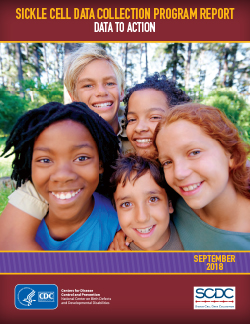SCDC Program Report: Data to Action
Pages in this Report
The Sickle Cell Data Collection (SCDC) program gathers health data from multiple sources to determine how many people live with sickle cell disease (SCD) in the United States and to learn about their use of healthcare services and health outcomes over time. The SCDC program shares this information with audiences who can drive improvements in SCD health care, treatment, and policy.
The primary goal of the SCDC program is to improve quality of life, life expectancy, and health among those living with SCD. Accomplishing this goal requires a joint effort across a variety of SCD stakeholders including providers, healthcare administrators, pharmaceutical companies, SCD community organizations, policymakers, public health organizations, and most importantly, patients and their advocates.
Continue reading to learn about the SCDC program, how the program has helped use data to drive action, and how it can equip SCD stakeholders with the evidence necessary to improve the lives of people with SCD.
About SCD
SCD is the most common inherited blood disorder in the United States, and affects an estimated 100,000 Americans.1 People with SCD have abnormal red blood cells that prevent blood from reaching the body’s tissues and organs, causing crippling pain, infection, and in some cases, stroke and other serious health problems. Although improvements in health care and treatment have enabled people with SCD to live into adulthood, the most severe form of SCD can shorten the lives of people with SCD by 20 to 30 years.2
These poor health outcomes are likely influenced by
- Limited or no access to quality, comprehensive care. The number of medical centers across the country that specialize in treating SCD are limited. Furthermore, most people with SCD do not live near these centers. The number of physicians trained and willing to treat patients with SCD, especially adult patients, is also limited. The majority of patients with SCD are on Medicaid — a 2004 study found that 66 percent of hospital stays for SCD were paid by Medicaid.3 Fewer than 70 percent of doctors in the United States accept new Medicaid patients.4
- Limited access to treatments. Hydroxyurea (HU), the most common drug used to treat SCD, is often under-prescribed to patients who may need it most.5
- Mistaken beliefs about people with SCD. Healthcare providers may wrongly believe that patients with SCD are drug-seekers and may doubt patient reports of severe pain.6 As a result, those with SCD often wait longer than those without SCD to see a doctor and to get pain medicines when visiting the emergency department.7
SCD is also a significant public health issue globally. In many African countries where SCD is common, up to 3 percent of newborns may have the disease.8 Studies suggest that 50 percent to 90 percent of children born with SCD in resource-poor regions die before age 5.8 Data indicate that up to 16% of the deaths of children younger than age 5 in some of these areas may be due to SCD.9 However, SCD is often not diagnosed, so it is rarely listed as the underlying cause of death among children. For these reasons, not enough attention is given to finding SCD early and properly managing the condition. The international burden of SCD has a domestic impact because many immigrants and refugees may move to the United States from countries where the disease is most common, but potentially undiagnosed.
The estimated cost of care for SCD in the United States is about $1.1 billion dollars per year,10 the majority of which is paid for through public insurance programs like Medicaid and Medicare. By understanding more about SCD through the SCDC program, the improvements to quality of life, life expectancy, and health may also result in reduced costs and less financial problems related to the disease.

